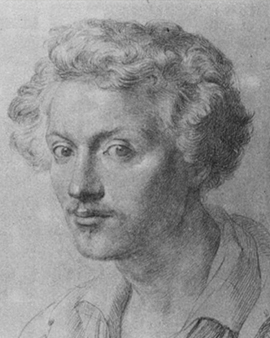Friedrich Nerly, whose real name was Nehrlich, was a German nature painter of the Romantic period. Although he was born in Thuringia, he spent most of his life in Italy, as his last name suggests. It was his views of Venice that made him most famous. The unique and beautiful lagoon city, which dominated the motifs of Nerly, exerted a great influence on his overall work.
The enthusiast Nerly lived in northern Italy from 1835 (until his death in 1878). He found his personal and artistic realization in a port city on the Adriatic Sea: Venice. This is evidenced first and foremost by his depiction of "The Piazzetta by Moonlight", which he painted a full 36 times. The extraordinary popularity of the painting is hardly surprising, because: It captures atmosphere and light mood in an inimitable way. His other watercolors and oil sketches also often depicted Venetian gondolas and palaces. In addition, Nerly joined the local art academy, he also married a local noblewoman. This marriage produced his son Friedrich Paul Nerly, who soon followed in his father's footsteps. His atmospheric works brought Friedrich Nerly the Elder great fame during his lifetime and many honors, such as elevation to the personal peerage. After his death, his work increasingly fell into oblivion. To counteract this, the son gave Nerly's artistic legacy - consisting of paintings and illustrations - to his hometown of Erfurt.
After the loss of his father, Friedrich Nerly, a native of Erfurt, had grown up in the Hanseatic city of Hamburg. His artistic talent and inclination showed early. After his first art lessons, he began an apprenticeship as a lithographer with his uncle - the engraver, etcher and draftsman Heinrich Joachim Herterich. Thus he quickly came into contact with artistic circles: with the graphic collector Johannes Michael Speckter or the painter of early Romanticism Philipp Otto Runge. His greatest patron was Carl Friedrich von Rumohr, the baron and painter taught the young artist "the perpetual study of real nature". In the process, not only his knack for landscape painting but also his eye for detail came to light. A joint journey took the teacher Rumohr and the student Nerly as far as southern Europe; on the way they met the poet and thinker Johann Wolfgang von Goethe in Weimar. The subsequent stay in Italy impressed Friedrich Nehrlich so much that from then on he called himself Nerly. At times he traded as Federico von Nerly. Without his experienced mentor and fatherly advisor Carl Friedrich von Rumohr, he set off for the south of the country. There the traveling artist explored, among other places, the Eternal City of Rome, where he met the painter, etcher and electroturner Johann Christian Reinhart.
×





.jpg)
.jpg)
.jpg)
.jpg)
.jpg)
.jpg)
 - (MeisterDrucke-83009).jpg)
 - (MeisterDrucke-83009).jpg)
 - (MeisterDrucke-113767).jpg)
 - (MeisterDrucke-113767).jpg)
_-_(MeisterDrucke-1634778).jpg)
_-_(MeisterDrucke-1634778).jpg)
.jpg)
.jpg)
.jpg)
.jpg)
_View_of_a_Town_(verso)_-_(MeisterDrucke-1618669).jpg)
_View_of_a_Town_(verso)_-_(MeisterDrucke-1618669).jpg)
_-_(MeisterDrucke-1315957).jpg)
_-_(MeisterDrucke-1315957).jpg)
.jpg)
.jpg)
.jpg)
.jpg)
.jpg)
.jpg)
.jpg)
.jpg)
.jpg)
.jpg)
.jpg)
.jpg)
 - (MeisterDrucke-65117).jpg)
 - (MeisterDrucke-65117).jpg)
.jpg)
.jpg)
.jpg)
.jpg)
.jpg)
.jpg)
_-_(MeisterDrucke-689649).jpg)
_-_(MeisterDrucke-689649).jpg)
.jpg)
.jpg)
.jpg)
.jpg)
.jpg)
.jpg)
.jpg)
.jpg)
.jpg)
.jpg)
.jpg)
.jpg)
.jpg)
.jpg)
.jpg)
.jpg)
.jpg)
.jpg)
.jpg)
.jpg)
.jpg)
.jpg)
_-_(MeisterDrucke-1544445).jpg)
_-_(MeisterDrucke-1544445).jpg)






